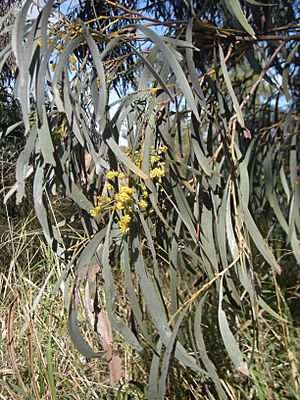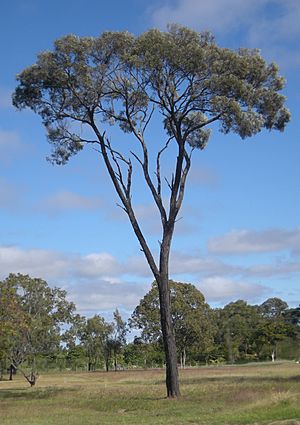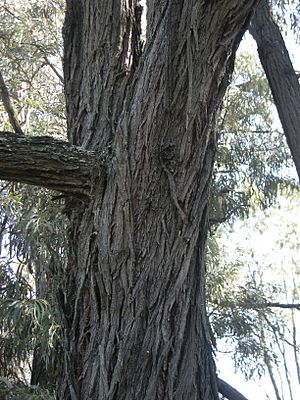Brigalow facts for kids
Quick facts for kids Brigalow |
|
|---|---|
 |
|
| Scientific classification | |
| Genus: |
Acacia
|
| Species: |
harpophylla
|
 |
|
| Occurrence data from AVH | |
| Synonyms | |
|
Racosperma harpophyllum |
|
The Brigalow (scientific name: Acacia harpophylla) is a special tree that grows only in Australia. It's also known as brigalow spearwood or orkor. The Gamilaraay Indigenous people call it Barranbaa or Burrii. You can find Brigalow trees in central and coastal Queensland and northern New South Wales. These trees can grow up to 25 meters (about 82 feet) tall. They often form large forests on clay soils.
Contents
What Does a Brigalow Tree Look Like?
The Brigalow tree can grow new trees from its roots. It has hard, dark bark with deep grooves. Its branches are smooth or slightly hairy, especially at the ends.
Like many Acacia trees, the Brigalow has phyllodes instead of true leaves. Phyllodes are flattened leaf stems that act like leaves. They are tough, silky, and stay green all year. They are curved like a sickle and are usually 10 to 20 cm (4 to 8 inches) long and 7 to 20 mm (0.3 to 0.8 inches) wide. They have many thin lines (nerves), with a few being more noticeable.
Flowers and Seeds
Brigalow trees bloom between July and October. Their flowers grow in small, round clusters, usually in groups of two to eight. Each flower cluster is about 5 to 8 mm (0.2 to 0.3 inches) wide and has 15 to 35 golden-colored flowers.
After the flowers, flat, smooth seed pods grow. These pods are straight or slightly curved and can be up to 20 cm (8 inches) long and 5 to 10 mm (0.2 to 0.4 inches) wide. They have lines running along them and are squeezed in between the seeds. Inside, the pods hold soft, dull brown seeds. The seeds are oblong or oval-shaped, flat but thick, and are 10 to 18 mm (0.4 to 0.7 inches) long.
Where Does Brigalow Grow?
Brigalow trees often grow with another type of Acacia tree called Gidgee (A. cambagei). They form open woodlands on flat or gently rolling land. These trees prefer heavy, fertile clay soils. You'll find them mainly in areas of Eastern Australia that get 300 to 700 mm (12 to 28 inches) of rain each year. These woodlands stretch from about 20 degrees South latitude down into northern New South Wales.
Brigalow and Gidgee can grow together in some places. They are also often found with other trees like Eucalyptus coolabah, Eucalyptus cambageana, and Casuarina cristata.
Rainfall and Height
Brigalow can grow in coastal areas that get over 900 mm (35 inches) of rain a year. It also grows in drier, semi-arid areas with about 500 mm (20 inches) of rain. However, it mostly lives in these semi-arid zones.
Gidgee trees take over from Brigalow in drier western regions, where rainfall is between 300 to 650 mm (12 to 26 inches). Gidgee trees are usually smaller, reaching about 12 meters (39 feet) tall, while Brigalow can grow up to 20 meters (66 feet).
In New South Wales, Brigalow is found from Roto in the south, to Hungerford in the east, and Willow Tree in the west, along the Great Dividing Range. In Queensland, it grows as far north as Townsville.
How Brigalow Got Its Name
The Brigalow tree was first officially described by a botanist named George Bentham in 1864. This description was part of his big book called Flora Australiensis.
Later, in 2001, another botanist named Leslie Pedley reclassified it. But then it was moved back to the Acacia group. The first sample of the tree that was used to describe it was collected near Rockhampton.
The scientific name harpophylla comes from the Greek words for "sickle-shaped leaf." This refers to the curved shape of the tree's phyllodes.
See also
 In Spanish: Brigalow para niños
In Spanish: Brigalow para niños



